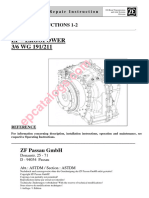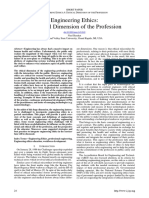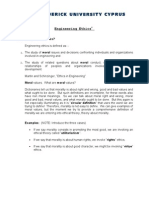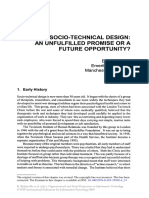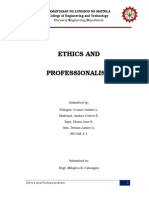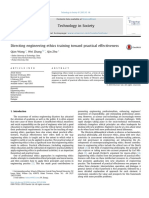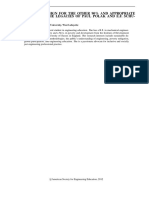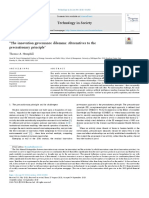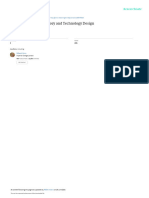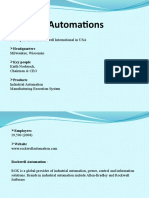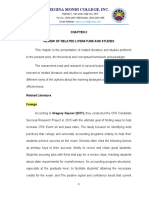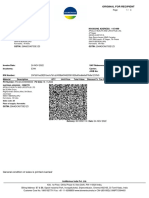Towards A Social Ethics of Engineering: The Norms of Engagement
Towards A Social Ethics of Engineering: The Norms of Engagement
Uploaded by
Salwa A AliCopyright:
Available Formats
Towards A Social Ethics of Engineering: The Norms of Engagement
Towards A Social Ethics of Engineering: The Norms of Engagement
Uploaded by
Salwa A AliOriginal Title
Copyright
Available Formats
Share this document
Did you find this document useful?
Is this content inappropriate?
Copyright:
Available Formats
Towards A Social Ethics of Engineering: The Norms of Engagement
Towards A Social Ethics of Engineering: The Norms of Engagement
Uploaded by
Salwa A AliCopyright:
Available Formats
Towards a Social Ethics of Engineering: The Norms of Engagement
RICHARD DEVON
Engineering Design and Graphics Pennsylvania State University members, of course) as ethical actors is spotty at best.7 It is possible that the failure of the professional societies to be more independent has contributed both to the confrontational themes and to the lack of interest in collective approaches to ethics. It has been suggested that engineers are already moral, and for engineering ethics to have meaning it must refer to a system that enhances the existing sum of the individual moralities of engineers that is already present.8 The codes of ethics that engineering societies have developed are not often taught, are not referred to by engineers in times of moral crisis,9 are not supported by the professional societies when engineers are in a crisis,10 or used to police the profession,11,12 and they do not represent any values not already pervasive in society. Admirably, and exceptionally, since 1996, IEEE has been trying to implement a series of reforms to support its code of ethics, including better dissemination of information, a hotline, and defense fund.13 Explicit in this conventional treatment of engineering ethics is the assumption that the appropriate unit of ethical analysis is the individual. This is problematic because technology is socially constructed and managed, and engineers are typically employees. While much may be learned about moral philosophy by using the individual as a unit of analysis, it is a little akin to studying atoms in order to understand a world composed of molecules, organisms, continents, rivers, and oceans. The scope of science is bigger than particle physics. Martin and Schinzinger, in their deservedly popular text, spend much time recognizing the central dilemma of the conventional approach: the employee status of most engineers. Yet they are obligated to fall back on wishful thinking. Managers must be responsive to engineers who exercise their consciences responsibly.14
ABSTRACT
A case is made for augmenting individual-based engineering ethics with a social ethics of technology framework. A social ethics approach takes as problematic the mutable social arrangements for decision making in technology. The example of the design group is used. It is suggested that this expanded approach is more relevant to technology decision-making, which is normally done collectively, than individual ethics alone. Recent changes in the social relations of industry are discussed as evidence that this expanded approach may be well received in the workplace.
I. INDIVIDUAL ETHICS
It has been argued that there have been three ideas concerning engineering ethics: The first emphasizes company loyalty, the second technocratic leadership, the third social responsibility.1 In this paper, a preliminary case is made for a new ideaor at least a new name: the social ethics of engineering. Instead of viewing ethics as a tension between the morality of the individual and the practices of society, it is suggested that the focus should be shifted to the tension between the ideal and the actual norms and structures that characterize group processes and social institutions. The focus should be the mutable social arrangements for technology decision-making. The advantage of this shift for engineering ethics is that it moves the focus from relatively powerless individuals to the actual processes of decision making in technology, thereby making engineering ethics more relevant than it has been. The advantage for the individual is that conflict is about process rather than product, and responsibility for outcomes is collective rather than just individual. The traditional approaches to engineering ethics have become a melange of the three main ideas noted by Mitcham and the tension between them.2 One result of this admixture is an advocacy of confrontation in the academic literature.3-4 A recent design text, for example, has a section on ethics in which admirable personal values are suggested and whistle blowing advocated as a natural consequence.5 On the other hand, the professional societies and their codes are quite the opposite in character and tend to be trailing indicators of social change, with the notable exception of changes being implemented at IEEE beginning in 1996.6 Both views stress individual accountability for anything that goes wrong and neither are well focused on the collective processes where decisions about technology are made. The record of professional societies (not their January 1999
II. SOCIAL ETHICS
It is proposed here that the real issue is exploring options in the social relations of expertise, not just exploring the moral dilemmas of individuals. Changes that have already taken place are instructive in this regard. The industries of many countries, but particularly Japan, have democratized manufacturing organizations in contrast to scientific management systems. The best industrial practice, whether here or overseas, now embraces much flatter organizations, the use of the expertise of all the workers rather than relying only on management experts, flexible manufacturing to be more responsive to the customer, just-in-time manufacturing, employee stock ownership plans, concurrent engineering, and many reforms driven by quality goals such as cooperative relationships with subcontractors.15 The result of this change in the social relations of expertise for Japan was global dominance in electronic appliances, care, and memory chips.16 It has been argued, with some exaggeration, that Journal of Engineering Education 87
the approach at Toyota, sometimes referred to as lean production, will eventually transform virtually every industry in the world.17 There are major implications for engineering ethics in this change because Lean production is built not simply on technical insight but on a precisely defined set of relationships that extends far beyond the factory floor to encompass designers, suppliers, and customers.17 Because these relationships have moved toward norms of participation by workers and the customers in the nature and quality of the process and product, respectively, the changes may be viewed in a positive ethical light. Presumably, neither ethics nor democracy drove these changes, but workers who have employee stock ownership plans and the power to stop the assembly line have come a long way from drones stripped of their expertise and pride by scientific management.18 The point being that such changes in the social organization of industry is extremely important ethically, and alternatives in these structures, real and potential, should be explored for their ethical significance. In this paper, it is argued that the more appropriate units of analysis in engineering ethics are collective configurations such as the engineers workgroup, the House of Representatives, town councils, and institutional arrangements such as the market economy and the now-defunct Office of Technology Assessment.19-20 Taking a social ethics approach means that engineering ethics must now embrace the way the world actually manages technology. In the case of risk management, for example, this includes statutes, standards (voluntary and mandatory), regulations, courts (tort and common law), insurance and compensatory plans, information flows, tax laws, government procurement practices, and so forth.20 These social arrangements not only produce and manage technology, but they are variable and may be designed in different ways. Studying the ethical implications of such possibilities is central to the work of a social ethics of technology. The example of the engineers workgroup in the case of a design team will be used below to illustrate the new approach. This is chosen for many reasons, but particularly because design is central to engineering, because it exemplifies the approach taken here, and because it is a highly relevant approach for engineering students about to enter the world of work. Hence the title: The Norms of Engagement. In stressing social ethics, the foci will be two-fold: cognizance and cooperation. Cognizance is important because unless technology decisionmaking is informed by an understanding of the likely social and environmental impacts, it really does not matter very much how moral the decision-makers are. At heart, technology represents two processes: it is a transformative part of the environment, and a transformative part of society. As Stefano Marzano, who heads Philips Corporate Design, noted in 1993, Design is a political act. Every time we design a product we are making a statement about the direction the world will move in. . . we must be aware of our power.22 This consequentialist statement should not be taken to rule out deontological positions, of course, because knowledge is often limited and ambiguous. Advocating cognizance is a position in common with social responsibility arguments for engineering ethics, but in social ethics, the social arrangements for shaping the development of such awareness, such as building diversity into a design team, is taken as a major concern. Cooperation is important because we must know how to work 88 Journal of Engineering Education
out our knowledge, ideas and values through collective processes. Otherwise, our values can only function under ethically primitive conditions where a few actors have sufficient power to do whatever they want, and the values of most individuals yield to the prevailing authority and/or culture. But most decision-making takes place in collective settings where knowledge of group, organizational, and other social processes, and of the different possibilities available, is essential to getting beyond considerations of the lone individual and the conflict between their values and their fiduciary obligations.
III. THE NORMS OF ENGAGEMENT
The norms of engagement refer to the ways in which engineers, and the non-engineers with whom they work, engage in their work by participating in group processes. Understanding these norms makes entry into the world of work more straightforward than a reliance on individualized ethics, which deny the collective nature of work and which stress the tension between the individual and the collective for which they work, e.g., between the persons ideals and the companys profits. This is not to suggest that the answer to the problem of engineering ethics is to stop agonizing and follow company policy, but that the focus should be on the organizational norms and group processes rather than the atomized values of each engineer. The collective approach also allows us to focus on important norms and processes that are very hard to address through the values of an individual. For example, how can we advocate flatter, more participatory organizations through studying the values of an individual? How do we examine, in ethical terms, the shift from sequential to concurrent engineering? How can we suggest that a design/product development group should be structured to include representatives from manufacturing and marketing, or include diversity in other ways such as social or intellectual? What could we say about the role of stakeholders? How can we argue for open brainstorming and other creative group processes in one person? Even valuing diversity or listening skills make much more sense as group norms adopted by group members than as individual values brought to the table, quite possibly in a confrontational way. As long as we are focused, rather ineffectually, on the question what makes a good engineer good, we are missing the even more important question of what makes a good technology good. As an example of studying the social arrangements for decision making in technology, a set of norms for a design team is suggested below. They are presented as an ideal to be debated, but they are supported for practical reasons in contemporary commentary on industrial competitiveness,23 and in some design literature.24-26 Many of these norms have been supported elsewhere in the engineering ethics literature, notably by Unger, even though his frame of reference is still the individual.27 A. Competency Perhaps the most fundamental ideas about the practice of engineering are that the engineer has the competency to realize an effective product, and that the product will achieve one or more of the following goals: make money, protect the country, or provide infrastructure. The implementation of the competency norm has several components, however. Clearly there must be methods for assessing the competency (degrees, licenses, and references), and of checking the work of any engineer for errors. It is also important to assign the January 1999
right competency to the right task. These ideas are old and well established and should be built into project management. However, a social ethics approach goes beyond considerations of the individuals competence and integrity to be concerned precisely with such management norms of assuring these things happen. The design of a design/product development team, which is critical to the success of the design endeavor, is open to many variations and there are some new configurations. The most notable of these is the switch from a design team to a product development team. There is also a growing sensitivity to the need for an equal role for manufacturing engineers and marketing experts in this process, and further, to bringing in experts from fields other than engineering such as art, ecology, and psychology. Indeed, design is a process that reaches beyond engineering entirely.28 Another point is the appearance of new competencies for engineers such as lifecycle analysis/ design for the environment, systems design, and decision theory.29,30 B. Cognizance It really is not very important how ethical engineers are, if they do not understand the implications of their designs. Technology is essentially transformative and it is incumbent on engineers and others on a design team to have open and inquiring minds with respect to the technological, social, and environmental implications of their work. And this cognizance depends on interdisciplinary skills and the breadth (representation) built into the group. This will positively affect the bottom line of a company by, for example, preventing pollution and reducing waste, and by increasing safety and customer satisfaction. Industry CEOs, for example, are increasingly interested in the many benefits of pollution prevention and reduced/zero-waste manufacturing.31 Even the town meeting approach to technology assessment being tried in some European countries has won industry converts who see the benefit of getting social reactions to new technologies as early as possible.32 An example of the importance of cognizance occurred in a recent seminar on green engineering. I heard a sympathetic structural engineering colleague comment that he did not see what environmental concerns had to do with buildings. Roodman and Lenssen note the following: Mining operations move more than 28 billion tons a year of the earths crust, which is more than all the rivers in the world. Buildings account for 40% of materials entering the global economy each year (50% of the copper). In 1992, structures accounted for about 1/3rd of total energy consumption. The life expectancy of buildings in Tokyo is 17 years, and, although 65% of the buildings in West Germany survived World War II, only 15% survived the next 30 years. Energy costs have driven a revolution in window technology, and materials cost have reduced the role of steel in buildings. There is much more to this story of buildings and their place in the ecosystem, but this should be enough to indicate their enormous ecological significance.33 Many companies, such as AT&T, Monsanto, and North American Philips, list a vice president as head of the environmental, or environmental and safety operations. Susan Cohn observes that the outlook for the green job market is good because the corporate interest is so strong.34 She quotes Monsantos CEO, Richard J. Mahoney, Unless we meet the environmental challenges, we wont be in business in ten years.35 January 1999
C. Democratic Information Flows Information is critical to design and manufacturing processes, but it is always corrupted by passage across a layer of authority whether going up or down. Flat organizations have been found more effective than those with many layers because much more information flows laterally and far fewer boundaries are crossed. Concurrent engineering, using product development teams that integrate design manufacturing and marketing successfully; carry this principle even further by eliminating the lateral barriers, such as the wall between design and manufacturing/ construction and that between both and marketing. Everyone has something to contribute and the use of quality circles, for example, has reversed the scientific management approach to good effect by incorporating, and benefiting from, the experience and intelligence of the shop floor workers and office workers. Open information flows also mean global searches for good ideas for the technological problems being addressed, so the norm is good for business in this way, as well.36 These changes in industry are probably not ephemeral but reflections of the decentralization, flattening of hierarchies, and globalization that, with information technology, increasingly characterize the global economy - even to the extent of weakening the nation state itself.37 An ethical corollary of these open information flows is more respect flowing between the participants. And open information flows enhance the acceptability of the final decisions and democratizes the process as a whole. Mitchams exploration of three case studies led him to a similar conclusion.38 D. Democratic Product Design and Development Teams Flatter organizations, participatory decision making where all parties have input, user centered design, all help towards achieving technology of the people, by the people, and for the people. This approach is very conducive to promoting the economic health of a company. RCA and Westinghouse both sold off the critical technology for the development of the huge flat-screen market because their organizations had become ossified with too many internal barriers that allowed existing product lines to be protected from company innovations.39 The post-construction crisis in the design of the Citicorp Center in 1978 was exacerbated by barriers between design and construction teams, just as its solution was facilitated by candor and cooperation within and between organizations as well as the single - minded efforts of LeMessurier.40 The need for a democratic structure is supported by the research on the very powerful influence of authority41 and peer pressure42 on behavior including cognitive assessments. The implication of the research in these areas is that democratic norms of participation, e.g., soft leadership and soft group relations, are very important if the best ideas are to emerge. This is supported by Cooper and Press who note that at Texas Instruments they have found that rotating the leadership is more effective than a single leader for the project duration.43 E. A Service Orientation User-centered design includes direct client participation and indirect client participation (the general public) through conferencing, technology assessment, market research, and hearings whereby the tradeoffs in design options are carefully laid out and evaluated. Good design requires good listening skills. This client orientation is critical to the very successful changes in Japanese industry. As Journal of Engineering Education 89
Taichi Ohno of Toyota put it, We are now unable to sell our products unless we think ourselves into the very hearts of our customers, each of whom has very different concepts and tastes.44 Toyota is considered by many as the top manufacturing company in the world and has led the world in flexible manufacturing. A recent visitor to their Tsutsumi plant saw just two assembly lines carry 91 different engines in 28 different models in just one day. These were in response to orders only two weeks old.45 GM has traditionally anticipated consumer demand by several years and built plants dedicated to just one model only to achieve major underutilization. Under Roger Smith, GM invested $77 billion in new plants and robots, but the result was not competitive with Toyota, which invested in training labor and customer satisfaction.45 In suggesting these norms it is understood that there will always be tradeoffs. For example, it should be noted that consumer-led design is corrupted by consumers being led design, so ethical issues are certainly not being laid to rest by customer needs assessment.46 F. Diversity A subset of participatory democratic processes is the valuation of diversity. It is not just a question of equity or tolerance. New ideas come from different people of different cultures and experiences, and these people also figure in the clientele. Stereotypic thinking in interpersonal relations may lead to stereotypic thinking when it comes to design options, also. Creativity requires going past misleading stereotypes. When facing uncertain futures, we need all the resources available that we can get. Social, ideational, and biological diversity all need nurturing, and all represent enrichment. Leifer reports that diversity enhances the creativity of a group,47 and in international business handling diversity becomes a necessity.48 Cooper and Press consider that Japanese companies have succeeded in part because of the value they place on multidisciplinary teams. They note that at Philips the new design approach has stressed cultural and environmental factors, and that even anthropologists were involved in the 1993 designs of their electric shavers.49 It must be a group norm for diverse people to work well together. Comprehension across ethnic and gender barriers can be improved where the dynamics are properly understood. G. Cooperativeness Another important group norm is cooperation and this should include conflict resolution skills. In this area, traditional approaches to ethics may even be a disadvantage. Attacking people for being unethical creates impasses that are very hard to get around. It is much easier to raise questions on relatively neutral bottom line grounds such as criticizing bigotry because it lowers productivity, or criticizing an unsafe design because of risk of future liability.50 Training in conflict resolution skills such as mediation, negotiation, cross cultural awareness (race, gender, cross-national)51 and interpersonal communication skills52 represent a good approach for a social ethics of engineering. Agreement, which a design process repeatedly requires, generally means getting past positional negotiation.53-6 Smith, in his review of American industry refers to trust as the most powerful motivator in the companies that are succeeding.57 Toyota management, in the GM collaboration at the NUMMI plant in Fremont, CA, made stunning turnarounds in manage90 Journal of Engineering Education
ment-workers relations using mostly the same work force that caused GM so much trouble that they closed the plant.58 Whereas GM is often accused of an anti-labor attitude and using tricks and automation, Toyota gives the workers power (to stop the assembly line, for instance) and respect (e.g., automation follows worker needs: first the dangerous work, then the dirty work, and then the heavy work.)58 H. Creativity Trial and error are critical in engineering and this needs to take place in safe and relatively inexpensive context, as opposed to Chernobyls and Edsels, for example. Ideas have to be explored and tried out. Fast, intelligent failure is one way to view this need to be both empirical and open-minded.59 All ideas come with ethical tradeoffs, and the more design ideas you have, the more likely you are to find one that is commercially, technically and ethically sound. Failure to embrace innovation can be costly. Smith argues that IBM, GM, RCA and many other American corporate giants got in trouble because their new ideas competed with their current profit lines and they held back the innovations.60 For example, IBMs John Cocke had the RISC idea in 1968, but Sun Microsystems was first to market it in 1986 almost 20 years later. Glenn Henry, a prestigious IBM Fellow, left IBM for Dell in 1988 after IBM management blocked his idea for a multimedia PC even though he had a working prototype.60
I. Project Management Skills Understanding project management includes knowing what expertise and duties are required and how to assign and manage them in a fail-safe way, and setting schedules and establishing good group norms, decision making, and conflict resolution procedures. Many famous case studies used in engineering ethics discussions often appear to have been a failure in project management, and building good project management practices into group behavior makes ethical sense. This topic needs a further paper, but some examples are suggested here. The lift slab construction collapse at LAmbiance Plaza apparently resulted from a failure to check a design for a critical shearhead lifting angle in the construction phase. The collapse was exacerbated by the non-enforcement of safety codes that required the workers to be out of the building during lifting.61-2 The case of the Aberdeen Three appears to have been a failure to train the engineers in the procedures and regulations for handling hazardous chemicals. Both the Citicorp crisis63-4 and the Hyatt Regency collapse of the walkway65 resulted, in part, from design changes during construction that considerably reduced the factor of safety and that occurred without discussion with the original designer. Concurrent engineering practices would have helped in these two cases. At Flixborough, a chemical plant was destroyed following an impromptu, incorrect, and unchecked coupling design by an engineer with expertise in chemical rather than mechanical engineering.66 There were many failures in the management of the Union Carbide plant at Bhopal.67-8 These cases seem to have more to do with project management failures than with ethical lapses of individuals. Project management is not necessarily taught in engineering schools, nor in companies where engineers work, which leaves room for problems. January 1999
IV. IMPLICATIONS FOR THE INDIVIDUAL
There are distinct advantages for individual engineers under the social ethics approach. Whereas the traditional approach only allows for the individual to be satisfied with the outcomes, the group approach allows for the possibility that the individual may be unhappy with the outcome but be able to accept it because the process was perceived as the most acceptable way for a group to achieve a design. Insofar as this happens already, it shows that social ethics are sometimes already at work. It does not show that individual ethics achieved this outcome. Individual ethics deal poorly with the social construction of a design, handling only those aspects that reflect on the integrity of the individual, such as conflicts of interest, and an individuals social responsibility. In a good group process, disaffection is also less likely to occur because the individual has a lot of input and because individuals can learn and change their mind better in an open process. Having much input and respecting the process represents improvements over traditional ethics. In the worst case, now rarer, there is still the traditional dilemma of the individual who cannot live with the consequences.
V. TEACHING THE ETHICS OF TECHNOLOGY
In education, where we prepare the young for their lives in other institutions, i.e., work, family, etc., we still rely largely on individual pedagogy characterized by interpersonal competition. So, traditionally, when we teach about ethics we practice what we preach and teach individual ethics using an individual based pedagogy. However, we should also teach group ethics with group pedagogy, such as problem/project based learning.69 The renaissance of design in the curriculum provides an obvious forum for doing so. This should enhance the teaching of teamwork that industry has been requesting for some time.70 Training in customer needs assessment, mediation, negotiation, and cross-cultural awareness may all be ways of achieving successful group norms. The author has had good success teaching conflict resolution skills to engineering students, and seniors report widespread interest by potential employers in teamwork and conflict resolution skills in their job interviews. Readers may agree with a social ethics approach while disagreeing with some of the norms suggested as an illustration here. This is the way it should be. Using a social ethics approach means understanding that there are choices in the way that we establish decisionmaking structures. Different arrangements produce different ethical outcomes. This is what we need to understand better: the ethics of developing, and choosing between, decision-making structures.
REFERENCES
1. Mitcham, C., Ethics into Design, in Richard Buchanan and Victor Margolin, (eds.), Discovering Design, University of Chicago, Chicago, 1995. 2. Johnson, D.G. (ed.), Ethical Issues in Engineering, Prentice Hall, Englewood Cliffs, New Jersey, 1991. 3. Baum, R., and A. Flores (eds.), Ethical Problems in Engineering, Rensselaer Polytechnic Institute, Albany, New York, 1978. 4. Weil, V., Beyond Whistleblowing: Defining Engineers Responsibilities, Holt Rhinehart and Winston, New York, 1983.
5. Dixon, J.R., and C. Poli, Engineering Design and Design for Manufacturing, Field Stone Publishers, Conway, Massachusetts, 1995. 6. Unger, S., Engineering Ethics: Whats New, IEEE Technology and Society Magazine, Fall, 1995, p.4. 7. Layton, E., The Revolt of the Engineers, Press of the Case Western Reserve University, Cleveland, Ohio, 1971. 8. Devon, R.F., A New Paradigm for Engineering Ethics, Proceedings, 1989 IEEE/SSIT Conference, IEEE/SSIT, 1989. Published as A Delicate Balance: Technics, Culture and Consequences, IEEE, 1990, pp. 81-86. 9. Kohn, P.M., and R.V. Hughson, Perplexing Problems in Engineering Ethics, Chemical Engineering, vol. 87, no. 59, May 5, 1980. 10. Berube, B.G., A Whistleblowers Perspective of Ethics in Engineering, Engineering Education, vol. 78, no. 5, February, 1988. 11. Wilson, D.E., Social Mechanisms for Controlling Engineers Performance, in Ref. #2. 12. Ladd, J., Collective and Individual Moral Responsibility in Engineering: Some Questions, IEEE Technology and Society Magazine, vol. 1, no. 2, June 1982. 13. Ref. 6. 14. Martin, M.W., and R. Schinzinger, Ethics in Engineering, McGraw-Hill, New York, 1989, pp. 11-12. 15. Dertouzos, M., et al., Made in America: Regaining the Productive Edge, M.I.T. Press, Cambridge, Massachusetts, 1989. 16. Smith, H., Rethinking America, Random House, New York, 1995. 17. Womack, J.P., D.T. Jones, and D. Roos, How Lean Production Can Change the World, New York Times Magazine, Part 2, September 23, 1990, p. 21. Adapted from their book The Machine that Changed the World, Macmillan, New York, 1990. 18. Braverman, H., Labor and Monopoly Capital: The Degradation of Work in the Twentieth Century, Monthly Review Press, New York, 1974. 19. Kunkle, G.C., New Challenge or the Past Revisited? The Office of Technology Assessment in Historical Context, Technology in Society, vol. 17, no. 2, 1995. 20. Institute for Technology Assessment, 2121 Wisconsin, Washington, DC, 20007. Tel.202 333 8887. 21. Merkhofer, M.W., Decision Science and Social Risk Management, D. Reidel, Boston, 1987. 22. Cooper, R., and M. Press, The Design Agenda: A Guide to Successful Design Management, John Wiley & Sons, Chicester, England, 1995, p. 138. 23. Refs. 15, 16, 17. 24. Ulrich, K.T., and S.D. Eppinger, Product Design and Development, McGraw-Hill, New York, 1995. 25. Ref. 22. 26. Lindbeck, J.R., Product Design and Manufacture, Prentice Hall, Englewood Cliffs, New Jersey, 1995, Chapters 1, 5, and 6. 27. Unger, S. H., Controlling Technology: Ethics and the Responsible Engineer, 2nd ed., Wiley & Sons, New York, 1994. 28. Devon, R.F., and D. Dorricott, The Pedagogy of Design, Proceedings, 1996 ASEE Annual Conference, ASEE, 1996. 29. Bienawski, Z.T., Designing a Design Degree in Engineering, Design Theory and Methodology, ASME, 1994, p. 3. 30. Ref. 22, pp. 248-250. 31. Cohn, S., Green at Work, Island Press, Washington, DC, 1992. 32. Schlove, Richard E., Town Meetings on Technology, Technology Review, July 1996, and also available at http://web.mit.edu/afs/athena/ org/t/techreview/www/articles/july96/schlove.html. 33. Roodman, D.M., and N. Lenssen, A Building Revolution: How Ecology and Health Concerns Are Transforming Construction, World Watch Institute, Washington, DC, 1995.
January 1999
Journal of Engineering Education 91
34. Ref. 28, pp. 5-6. 35. Ref. 28. 36. Ref. 15. 37. Guehenno, Jean-Marie, The End of the Nation State, Minneapolis: University of Minnesota Press, 1992. 38. Mitcham, C., Engineering Design Research and Social Responsibility, in Kristin Shrader-Frechette, (ed.), Ethics of Scientific Research, Rowman & Littlefield, Lanham, Maryland, 1994, p. 159. 39. Ref. 16. 40. Morgenstern, J., The Fifty-Nine Story Crisis, New Yorker, May 29, 1995. 41. Millgram, S., Obedience to Authority, Harper-Colophon, New York, 1974. 42. Asch. S., Effects of Group Pressure Upon the Modification and Distortion of Judgements, in H. Proshansky and B. Seidenberg (eds.), Basic Studies in Social Psychology, Holt, Rhinehart, and Winston, New York, 1965, pp. 393-401. 43. Ref. 22, pp. 171, 247. 44. Ref. 16, p. 50. 45. Ref. 16, p. 51. 46. Whiteley, N., Design for Society, University of Washington Press, Seattle, Washington, 1993. 47. Leifer, Larry, Design Team Performance: Metrics and the Impact of Technology, Evaluating Corporate Training: Models and Issues, Kluwer, forthcoming, chapter 14. 48. Lane, Henry W., J. DiStefano, and M. L. Maznevski, International Management Behavior. Cambridge, Mass., Blackwell, Part One, 1997. 49. Ref. 21, p.122. 50. Ref. 8. 51. Gray, Barbara, Collaborating: Finding Common Ground for Multiparty Problems, San Francisco, Jossey-Bass, 1989. 52. Covey, S.R., The Seven Habits of Highly Effective People, Restoring the Character Ethic, Simon and Schuster, New York, 1989. 53. Fisher, R., and W. Ury, Getting to Yes: Negotiation Agreement Without Giving In, Houghton Mifflin, Boston, 1981. 54. Folger, J.P., and M.S. Poole, Working Through Conflict: A Communication Perspective, Scott Foresman and Co., Glenview, Illinois, 1984. 55. Kaye, K., Workplace Wars and How to End Them: Turning Personal Wars into Productive Teamwork, American Management Association, New York, 1994. 56. Schrage, M., No More Teams, Doubleday, New York, 1990. 57. Ref. 16, p. XXII. 58. Ref. 16, p. 63, et passim. 59. Matson, J.V., Using Fast Intelligent Failure, The Leonhard Center, Penn State University, University Park, Pennsylvania, 1991. 60. Ref. 16, Part One. 61. Poston, Randall W., Gerard C. Feldman, and Mario G. Suarez, Evaluation of LAmbiance Plaza Posttensioned Floor Slabs, Journal of Performance of Constructed Facilities, vol. 5, no. 2, May, 1991, pp. 75-91. 62. Scribner, C. F., and C.G. Culver, Investigation of the Collapse of the LAmbiance Plaza, Journal Performance of Constructed Facilities, vol. 2, no. 2, 1988, pp. 58-79. 63. Ref. 40. 64. William LeMessurier: The Fifty-Nine-Story Crisis; A Lesson in Professional Behavior, The World Wide Web Ethics Center for Engineering and Science, http://web.mit.edu/ethics/www /LeMessurier/lem.html. 65. Petroski, H., To Engineer is Human: The Role of Failure in Successful Design, St. Martins Press, New York, 1985.
66. Taylor, H.D., Flixborough: Implications for Management, Keith Shipton Developments Limited, London Bridge, London, 1975. 67. Bhopal: The Disaster and The Aftermath, http://dirac.py.iup.edu/college/chemistry/chem-course/sford1.txt. 68. TED Case Studies Bhopal Disaster, Trade and Environment Database, TED Super Page, http://gurukul.ucc.american.edu/ted/BHOPAL.htm. 69. Hmelo, Cindy E., Problem-Based Learning: Development of Knowledge and Reasoning Strategies, in J.D. Moore and J.F. Lehman (eds.), Proceedings of the Seventeenth Annual Conference of the Cognitive Science Society, Erlbaum, Hillsdale, New Jersey, pp. 403-408. 70. Garry, F.W., What Does Industry Need? A Business Look at Engineering Education, Engineering Education, January 1986, pp. 204-5.
92
Journal of Engineering Education
January 1999
You might also like
- ZF 3-6-191 - 211 - e Repair ManualDocument6 pagesZF 3-6-191 - 211 - e Repair ManualarthurNo ratings yet
- 6 Manufacturing PlanDocument12 pages6 Manufacturing PlanVincent FajardoNo ratings yet
- E NGR 183EW SyllabusDocument3 pagesE NGR 183EW SyllabusMrFunkyMushroomNo ratings yet
- HVPE Case StudyDocument23 pagesHVPE Case StudyNandit Bhardwaj100% (1)
- Professional Ethics and Human ValuesDocument6 pagesProfessional Ethics and Human ValuesDishani LahiriNo ratings yet
- Social Responsibility of Engineering Institutions With Special Reference of DTUDocument10 pagesSocial Responsibility of Engineering Institutions With Special Reference of DTUMohit YadavNo ratings yet
- Handout 1Document32 pagesHandout 1rabee3732No ratings yet
- HUM Quiz 1 NoteDocument19 pagesHUM Quiz 1 NoteSaquibNo ratings yet
- Engineering Ethics A Critical Dimension of The ProDocument5 pagesEngineering Ethics A Critical Dimension of The Prohitesh reddyNo ratings yet
- Engineering Ethics IntroductionDocument6 pagesEngineering Ethics Introductiongdayanand4uNo ratings yet
- Engineering Ethics: An Integrated Approach: Darlington S. Y. David, Melvin M. KollieDocument4 pagesEngineering Ethics: An Integrated Approach: Darlington S. Y. David, Melvin M. KollieVindhesh KumarNo ratings yet
- Excerpt From Engineers Ethics Ans Sustainable development-MaríaC SPRDocument4 pagesExcerpt From Engineers Ethics Ans Sustainable development-MaríaC SPRAdan Marrero RodriguezNo ratings yet
- Ethical Framework For Designing Autonomous IntelliDocument12 pagesEthical Framework For Designing Autonomous Intellimalakalsaleh05No ratings yet
- Promoting EthicsDocument6 pagesPromoting EthicsNicolae CameliaNo ratings yet
- Engineers, Ethics and Sustainable DevelopmentDocument15 pagesEngineers, Ethics and Sustainable Developmentmichaelliau100% (1)
- Engineering EthicsDocument13 pagesEngineering EthicsHAMZA KHANNo ratings yet
- Toward A Social Ethic of TechnologyDocument17 pagesToward A Social Ethic of TechnologydianaNo ratings yet
- Summary of Chapter 1: Engineers: Professionals For The Human GoodDocument4 pagesSummary of Chapter 1: Engineers: Professionals For The Human GoodMarkNo ratings yet
- Social Responsibilities Are A Part of All ProfessionsDocument2 pagesSocial Responsibilities Are A Part of All ProfessionsMuhammad Danish FahimNo ratings yet
- Introduction To Ethics and ProfessionalismDocument7 pagesIntroduction To Ethics and ProfessionalismKristine AbanadorNo ratings yet
- Social Aspect of EngineeringDocument7 pagesSocial Aspect of EngineeringBharath RaghavanNo ratings yet
- Professional Ethics 2023Document12 pagesProfessional Ethics 2023Ali Murtaza (Ali)No ratings yet
- Vinayaka Mission University. V.M.K.V.Engineering College. SalemDocument47 pagesVinayaka Mission University. V.M.K.V.Engineering College. SalemanniejenniNo ratings yet
- 04 - Mumford2000 - Chapter - Socio-TechnicalDesignAnUnfulfiDocument14 pages04 - Mumford2000 - Chapter - Socio-TechnicalDesignAnUnfulfiMurat KarabulutNo ratings yet
- Business and The Ethical Implications of TechnologDocument12 pagesBusiness and The Ethical Implications of TechnologianjohnboroNo ratings yet
- Ethics and ProfessionalismDocument7 pagesEthics and ProfessionalismCeazar Justine FuluganNo ratings yet
- Ethics Creative Problem SolvingDocument9 pagesEthics Creative Problem SolvingmrNo ratings yet
- Engineering EthicsDocument6 pagesEngineering EthicsTuğşan AltuğNo ratings yet
- Transforming Society by Transforming Technology: The Science and Politics of Participatory DesignDocument34 pagesTransforming Society by Transforming Technology: The Science and Politics of Participatory DesignJoarez Silas BarnabeNo ratings yet
- Engineering Ethics: To Cite This VersionDocument4 pagesEngineering Ethics: To Cite This VersionMohamed AliNo ratings yet
- Professional Ethics 1Document9 pagesProfessional Ethics 1Moawia MabroukNo ratings yet
- Technology Transfer: Technology Transfer Is A Process of Changing The Technology To A New SettingDocument29 pagesTechnology Transfer: Technology Transfer Is A Process of Changing The Technology To A New SettingsaravananNo ratings yet
- Nair Pragmatism and Care in Engineering Ethics 2019Document23 pagesNair Pragmatism and Care in Engineering Ethics 2019IonCotrutaNo ratings yet
- PEDocument17 pagesPEyoyokb404No ratings yet
- Engineering Ethics and Management Decision-MakingDocument10 pagesEngineering Ethics and Management Decision-MakingInternational Journal of Innovative Science and Research TechnologyNo ratings yet
- GEEM Mid Term Crash CourseDocument5 pagesGEEM Mid Term Crash CourseMTE1991No ratings yet
- MainDocument6 pagesMainsophie adibNo ratings yet
- PE11Document34 pagesPE11joshiknihaal24No ratings yet
- Professional: Ethics in EngineeringDocument141 pagesProfessional: Ethics in EngineeringPriyankhaNo ratings yet
- Are Codes of Ethics UsefulDocument5 pagesAre Codes of Ethics UsefulKalimullah KhanNo ratings yet
- Ethics - Midterm: Life As EngineersDocument19 pagesEthics - Midterm: Life As EngineersAdham Aboul KheirNo ratings yet
- Useful Servant or Dangerous Master? Technology in Business and Society DebatesDocument30 pagesUseful Servant or Dangerous Master? Technology in Business and Society DebatesJoshua Benedict CoNo ratings yet
- 2006 Vande Poel Verbeek Ethicsand Engineering Design STHVDocument14 pages2006 Vande Poel Verbeek Ethicsand Engineering Design STHVmghaseghNo ratings yet
- Determination of Portfolio Codes of Ethics in Innovation ManagementDocument11 pagesDetermination of Portfolio Codes of Ethics in Innovation ManagementInternational Journal of Application or Innovation in Engineering & ManagementNo ratings yet
- Eis EssayDocument11 pagesEis Essayseharis7No ratings yet
- Directing Engineering Ethics Training Toward Practical EffectivenessDocument4 pagesDirecting Engineering Ethics Training Toward Practical EffectivenessNicolae CameliaNo ratings yet
- Ethics Why Is It Important and How Can We Teach It For Engineering and Construction StudentsDocument8 pagesEthics Why Is It Important and How Can We Teach It For Engineering and Construction Studentsafaq AhmadNo ratings yet
- Ethics in Eng Lec1-F16Document57 pagesEthics in Eng Lec1-F16Hanzla AfzalNo ratings yet
- Nature and Objective of EthicsDocument6 pagesNature and Objective of EthicsRajdeep PaulNo ratings yet
- Ethics by Design 1608563252Document37 pagesEthics by Design 1608563252Adrian CristinaNo ratings yet
- New Ethical Challenges For Today Engineering and TechnologyDocument7 pagesNew Ethical Challenges For Today Engineering and TechnologyAndreea MadalinaNo ratings yet
- See TargetingDocument18 pagesSee TargetingKevin SardiniNo ratings yet
- Technological Forecasting & Social Change-1Document9 pagesTechnological Forecasting & Social Change-1Sirisha NNo ratings yet
- Lecture 2Document10 pagesLecture 2Katia KisswaniNo ratings yet
- Engineering Ethics Updated - 104717Document26 pagesEngineering Ethics Updated - 104717criticalshot15No ratings yet
- ME-LAWSDocument110 pagesME-LAWSLuis BergonioNo ratings yet
- The Innovation Governance Dilemma - Alternatives To The Precautionary Principleâ (Technology in Society, Vol. 63) (2020)Document9 pagesThe Innovation Governance Dilemma - Alternatives To The Precautionary Principleâ (Technology in Society, Vol. 63) (2020)sor ronNo ratings yet
- Engineering Ethics: Chapter 1Document34 pagesEngineering Ethics: Chapter 1Ahmad Shdifat100% (2)
- SDTHandbookChapter 6jul21Document38 pagesSDTHandbookChapter 6jul21patriciatartacovskyNo ratings yet
- 0401 Professional Ethics B Tech It Iv Year Vii SemesterDocument135 pages0401 Professional Ethics B Tech It Iv Year Vii SemesterALKESH KUMRAWATNo ratings yet
- The Smart Mission: NASA’s Lessons for Managing Knowledge, People, and ProjectsFrom EverandThe Smart Mission: NASA’s Lessons for Managing Knowledge, People, and ProjectsRating: 5 out of 5 stars5/5 (1)
- MattDocument7 pagesMattSalwa A AliNo ratings yet
- Embedded System Course Code: 3361105Document7 pagesEmbedded System Course Code: 3361105Salwa A AliNo ratings yet
- Using OPNET To Teach Students Computer Networking Subject: Mayyada Hammoshi, Razan Al-AniDocument12 pagesUsing OPNET To Teach Students Computer Networking Subject: Mayyada Hammoshi, Razan Al-AniSalwa A AliNo ratings yet
- Embedded System Course Code: 3361105Document7 pagesEmbedded System Course Code: 3361105Salwa A AliNo ratings yet
- Safety and Security Checks For Containers: Code of Practice 612Document15 pagesSafety and Security Checks For Containers: Code of Practice 612gustavoseseNo ratings yet
- Labor Law Review Atty V DuanoDocument69 pagesLabor Law Review Atty V DuanoLei Bumanlag100% (2)
- 3rd Quarterly Exam - EntrepDocument4 pages3rd Quarterly Exam - Entrepmarie joy francisco100% (1)
- Indian Economy Boom or Boon 2022Document11 pagesIndian Economy Boom or Boon 2022Aakash MalhotraNo ratings yet
- Rockwell AutoDocument16 pagesRockwell AutoabhinaybthNo ratings yet
- Audit M. Test Question EM 23.03.2024Document8 pagesAudit M. Test Question EM 23.03.2024tandelmohik10No ratings yet
- RRLSDocument22 pagesRRLSRizeth Ahne Marie GarayNo ratings yet
- Accounting Books - Journal and LedgerDocument15 pagesAccounting Books - Journal and LedgerClair De luneNo ratings yet
- Finance ExamDocument14 pagesFinance ExamAnanthu NairNo ratings yet
- Palong Timur 6 Invoice Bulan 1Document2 pagesPalong Timur 6 Invoice Bulan 1Ďïńệsh ŔäjNo ratings yet
- 08 12 OcrDocument5 pages08 12 Ocrastig79No ratings yet
- Case Studies of Organizational BehaviourDocument10 pagesCase Studies of Organizational Behaviourrs6488152No ratings yet
- Tax Invoice TN2200313738 Original For Recipient: Sold-ToDocument4 pagesTax Invoice TN2200313738 Original For Recipient: Sold-ToG Sandeep BelurNo ratings yet
- Asia: The Highway of Value For Global LogisticsDocument7 pagesAsia: The Highway of Value For Global LogisticsPranav choudharyNo ratings yet
- MiCA Compromises v7 (28 Feb 2022) Track ChangesDocument151 pagesMiCA Compromises v7 (28 Feb 2022) Track ChangesMike McSweeneyNo ratings yet
- Aon - 2022-23 Phase IDocument104 pagesAon - 2022-23 Phase Itabrez khanNo ratings yet
- CH - 4 DMIDocument37 pagesCH - 4 DMIAlemtideg AlemayehuNo ratings yet
- Training Programme On Disaster Management For Officials of Indian RailwaysDocument7 pagesTraining Programme On Disaster Management For Officials of Indian RailwayspramodNo ratings yet
- Code of Ethics Part B Section 290, 291Document16 pagesCode of Ethics Part B Section 290, 291Hasitha AravindaNo ratings yet
- Advanced Returns Management 2 - SAP DocumentationDocument5 pagesAdvanced Returns Management 2 - SAP DocumentationFabrizio CiavolaNo ratings yet
- Annex SL: High Level StructureDocument1 pageAnnex SL: High Level Structureqc_531040655No ratings yet
- 5TH International Conference On Advances in MechanicalDocument4 pages5TH International Conference On Advances in Mechanicalxyric porteNo ratings yet
- Melanie Robinson: Work History SkillsDocument1 pageMelanie Robinson: Work History SkillsEharyry brahimNo ratings yet
- Cof. DenisonDocument3 pagesCof. Denisonhumphery AhenkoraNo ratings yet
- Berikut Adalah Neraca CV JA2 Maju Bersama Pada Saat PendirianDocument6 pagesBerikut Adalah Neraca CV JA2 Maju Bersama Pada Saat PendirianIrbah ShildamNo ratings yet
- ABB - SECCIONADOR - 68506891-Switch-Disconnector-Switch-Disconnector-Oetl-Nf-1200-1200a-600v-50kaDocument1 pageABB - SECCIONADOR - 68506891-Switch-Disconnector-Switch-Disconnector-Oetl-Nf-1200-1200a-600v-50kaJosé Antonio Mayol Del VecchioNo ratings yet
- Eccsa Five Year (2014 15 - 2018 19) Strategic PlanDocument95 pagesEccsa Five Year (2014 15 - 2018 19) Strategic Planyayehyirad100% (1)
- Electric Package PaymentDocument2 pagesElectric Package PaymentRasha AbdullahNo ratings yet
